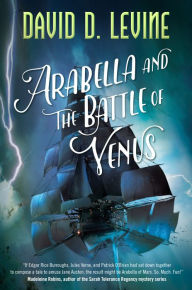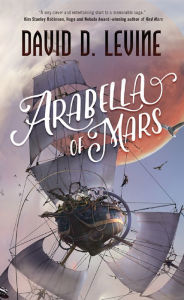Not Just Another Plucky Heroine: Arabella and the Battle of Venus
 Earlier this year, David D. Levine’s Arabella of Mars picked up the Andre Norton Award for Young Adult Science Fiction and Fantasy, and with good reason—it’s a charming callback to Victorian adventure novels, full up to the brim with pirates and swashbuckling, automata and cross-dressing, close calls and cunning escapes. Arabella herself is a fresh and fun heroine, with just enough single-mindedness to pull off some thoroughly hare-brained schemes. The world, well, it’s something like Jules Verne’s From the Earth to the Moon crossed with Stevenson’s Treasure Island and Burroughs’ A Princess of Mars. Arabella and the Battle of Venus continues this winning mix of steampunk-y anachronism and plucky adventure novel, flinging our Arabella out of one tight spot and into another.
Earlier this year, David D. Levine’s Arabella of Mars picked up the Andre Norton Award for Young Adult Science Fiction and Fantasy, and with good reason—it’s a charming callback to Victorian adventure novels, full up to the brim with pirates and swashbuckling, automata and cross-dressing, close calls and cunning escapes. Arabella herself is a fresh and fun heroine, with just enough single-mindedness to pull off some thoroughly hare-brained schemes. The world, well, it’s something like Jules Verne’s From the Earth to the Moon crossed with Stevenson’s Treasure Island and Burroughs’ A Princess of Mars. Arabella and the Battle of Venus continues this winning mix of steampunk-y anachronism and plucky adventure novel, flinging our Arabella out of one tight spot and into another.
Arabella and the Battle of Venus
Arabella and the Battle of Venus
Hardcover $25.99
It’s been several months since the events of Arabella of Mars, which found our titular character posing as a cabin boy aboard the HMS (Honorable Mars Ship) Diana, fending off privateers, landing on the red planet with a daredevil maneuver, personally intervening in a Martian uprising, and getting engaged. Not many of us could boast a 17th (and 18th) year as eventful as Miss Arabella’s, but things seem to have settled down in the interim. Her brother is running the plantation credibly; her fiancé, Captain Singh, is off on some trade mission to Venus; and Arabella is absolutely dying of boredom and chaffing against stifling Victorian expectations of young ladies, even those living on backwater plantations of colonial Mars.
Which is why, when she learns of Captain Singh’s capture and confinement by the dreaded Napoleon, it is something of a mixed blessing. She gets to get off of stifling Mars, but her captain is in trouble. (In this alternate history, Bonaparte has escaped his exile on the Moon, instead of Elba, and has conquered Venus before his last push to engage Earth.) Arabella is a person at her best when doing things, and though she has a young person’s impulsiveness and naïveté, she tends also to have pretty good instincts. Rapidly, she finds herself devising a somewhat foolhardy plan to rescue Captain Singh, gulling her less forceful older brother into funding her mission, hiring out with privateers, and hurtling out into the interplanetary air to ply the rough winds between Mars and Venus.
Maybe I should back up. Remember how I likened the world of the Arabella novels to Jules Verne? In this alternate history (or maybe alternate reality is more precise), the space between the planets is filled with air that roils and circulates just as surely as any ocean. Airships ply this medium, escaping the mass of the planet through hot air balloons, rowing or sailing their way through the treacherous currents of the interplanetary airstream. Both Arabella and the Battle of Venus and its predecessor spend considerable amounts of time in the air, concerned with the practical necessities of an airship’s flight. Whilein the first book, the action largely takes place in the air, bookended by events planetside, Arabella and the Battle of Venus inverts this: after an eventful flight to Venus aboard a privateer’s ship, Arabella and her shipmates are captured and interred by Bonaparte’s forces. She’s reunited with her beloved Captain Singh, but in the meanest and most unpleasant of climes.
It’s been several months since the events of Arabella of Mars, which found our titular character posing as a cabin boy aboard the HMS (Honorable Mars Ship) Diana, fending off privateers, landing on the red planet with a daredevil maneuver, personally intervening in a Martian uprising, and getting engaged. Not many of us could boast a 17th (and 18th) year as eventful as Miss Arabella’s, but things seem to have settled down in the interim. Her brother is running the plantation credibly; her fiancé, Captain Singh, is off on some trade mission to Venus; and Arabella is absolutely dying of boredom and chaffing against stifling Victorian expectations of young ladies, even those living on backwater plantations of colonial Mars.
Which is why, when she learns of Captain Singh’s capture and confinement by the dreaded Napoleon, it is something of a mixed blessing. She gets to get off of stifling Mars, but her captain is in trouble. (In this alternate history, Bonaparte has escaped his exile on the Moon, instead of Elba, and has conquered Venus before his last push to engage Earth.) Arabella is a person at her best when doing things, and though she has a young person’s impulsiveness and naïveté, she tends also to have pretty good instincts. Rapidly, she finds herself devising a somewhat foolhardy plan to rescue Captain Singh, gulling her less forceful older brother into funding her mission, hiring out with privateers, and hurtling out into the interplanetary air to ply the rough winds between Mars and Venus.
Maybe I should back up. Remember how I likened the world of the Arabella novels to Jules Verne? In this alternate history (or maybe alternate reality is more precise), the space between the planets is filled with air that roils and circulates just as surely as any ocean. Airships ply this medium, escaping the mass of the planet through hot air balloons, rowing or sailing their way through the treacherous currents of the interplanetary airstream. Both Arabella and the Battle of Venus and its predecessor spend considerable amounts of time in the air, concerned with the practical necessities of an airship’s flight. Whilein the first book, the action largely takes place in the air, bookended by events planetside, Arabella and the Battle of Venus inverts this: after an eventful flight to Venus aboard a privateer’s ship, Arabella and her shipmates are captured and interred by Bonaparte’s forces. She’s reunited with her beloved Captain Singh, but in the meanest and most unpleasant of climes.
Arabella of Mars
Arabella of Mars
Paperback $7.99
The time spent on Venus ends up being something of a slog, somewhat literally, because the environment is steamy and hot, and their living conditions harsh and unpleasant. But also, it feels like ages during which Arabella tries fruitlessly to help the interred airmen, but without a real understanding of what is going on, both with Captain Singh, or the larger war effort. Something of a love triangle is introduced between Arabella, Singh, and the privateer captain, which doesn’t always feel convincing. Singh himself is more withholding with important information than I found likely. But eventually, this middle section picks up, and they start planning their escape in earnest. There’s even a play within a play! (Fittingly, it’s Shakespeare’s Twelfth Night, and of course, Arabella plays Viola.)
Arabella and the Battle of Venus is an engaging adventure story, one that deepens our understanding of our most important characters while introducing us to people we’d like to know more about. I often weary of plucky girls who eschew all trappings of their gender, and Arabella threatened to become of them. I enjoyed the introduction of the character of her chaperone, Lady Corey (who we met briefly at the end of Arabella of Mars); Lady Corey annoys Arabella, enforcing norms she sees as superfluous and ridiculous. But Lady Corey is well more politically deft than Arabella, and schools her well in the utility of being underestimated by your enemies. If I’ve learned anything from these novels, it’s that underestimating Arabella is a big mistake. I look forward to her next outing.
Arabella and the Battle of Venus is available now.
The time spent on Venus ends up being something of a slog, somewhat literally, because the environment is steamy and hot, and their living conditions harsh and unpleasant. But also, it feels like ages during which Arabella tries fruitlessly to help the interred airmen, but without a real understanding of what is going on, both with Captain Singh, or the larger war effort. Something of a love triangle is introduced between Arabella, Singh, and the privateer captain, which doesn’t always feel convincing. Singh himself is more withholding with important information than I found likely. But eventually, this middle section picks up, and they start planning their escape in earnest. There’s even a play within a play! (Fittingly, it’s Shakespeare’s Twelfth Night, and of course, Arabella plays Viola.)
Arabella and the Battle of Venus is an engaging adventure story, one that deepens our understanding of our most important characters while introducing us to people we’d like to know more about. I often weary of plucky girls who eschew all trappings of their gender, and Arabella threatened to become of them. I enjoyed the introduction of the character of her chaperone, Lady Corey (who we met briefly at the end of Arabella of Mars); Lady Corey annoys Arabella, enforcing norms she sees as superfluous and ridiculous. But Lady Corey is well more politically deft than Arabella, and schools her well in the utility of being underestimated by your enemies. If I’ve learned anything from these novels, it’s that underestimating Arabella is a big mistake. I look forward to her next outing.
Arabella and the Battle of Venus is available now.

